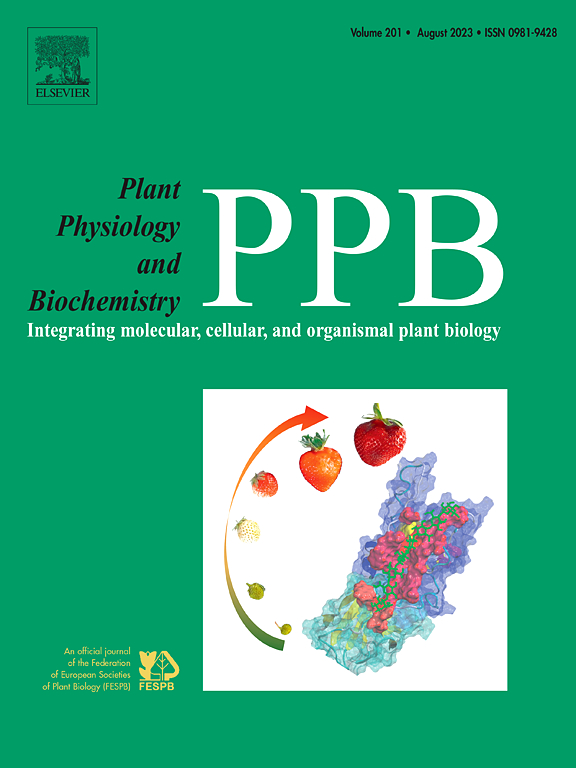盐胁迫下水稻耐受性和敏感性地方品种的非靶向代谢组学分析
IF 5.7
2区 生物学
Q1 PLANT SCIENCES
引用次数: 0
摘要
盐碱化是影响水稻生产的主要非生物胁迫,它通过破坏土壤结构和破坏植物的主要生理过程来实现。地方品种具有较高的遗传多样性,对包括社会性在内的各种环境胁迫表现出较强的适应性。在本研究中,我们筛选了47个地方品种,并根据形态生理特征确定了Norungan对社会的高度耐受性。此外,我们还研究了Norungan和Vellai Kudaivazhai(高度敏感的地方品种)在对照和酸度胁迫条件下的生化和代谢反应。生化分析表明,Norungan与Vellai Kudaivazhai具有较好的光合作用、较低的脂质过氧化和较高的抗氧化酶活性,并为其耐受性提供了初步证据。对Norungan和Vellai Kudaivazhai的非靶向代谢组学分析分别鉴定出103和117个差异积累代谢物(DAMs)。与Vellai Kudaivazhai相比,Norungan的大坝通过TCA循环和GABA分流更有效地利用了能量,同时有效的蔗糖稳态减少了通过死细胞的碳泄漏。尽管Norungan表现出有效的蔗糖稳态,减少了通过死细胞的碳泄漏,但脯氨酸等主要渗透物的上调(Fold change - 5.32)进一步强调了其耐受性。此外,丰富的淀粉和蔗糖代谢途径,以及TCA循环,突出了诺龙根耐碱的适应机制。综上所述,这些发现为了解耐盐机制提供了有价值的见解,这可能为提高水稻耐盐性的有针对性的育种策略提供信息。本文章由计算机程序翻译,如有差异,请以英文原文为准。
Untargeted metabolomics analysis in tolerant and susceptible landraces of rice under sodicity stress
Sodicity is a major abiotic stress affecting rice production by disrupting soil structure and impairing major physiological processes in plants. Landraces possess high genetic diversity and exhibit strong adaptation to diverse environmental stresses, including sodicity. In the present study, we screened 47 landraces and identified Norungan as highly tolerant to sodicity based on morpho-physiological traits. Further, we characterized the biochemical and metabolic responses of Norungan and Vellai Kudaivazhai (Highly susceptible landrace) under control and sodicity stress conditions. Biochemical analysis revealed that efficient photosynthesis, reduced lipid peroxidation, and elevated antioxidant enzyme activities distinguished Norungan from Vellai Kudaivazhai and provided primary evidence supporting its tolerance. Untargeted metabolomics analysis of Norungan and Vellai Kudaivazhai identified 103 and 117 differentially accumulated metabolites (DAMs), respectively. The DAMs in Norungan indicated more efficient energy utilization through the TCA cycle and GABA shunt compared to Vellai Kudaivazhai, along with effective sucrose homeostasis that minimized carbon leakage via dead cells. Although, Norungan exhibited effective sucrose homeostasis, minimizing carbon leakage through dead cells, the upregulation of major osmolytes, such as proline (Fold change – 5.32) further underscored its tolerance. Additionally, the enrichment of pathways such as starch and sucrose metabolism, and the TCA cycle, highlighting Norungan's adaptive mechanisms underlying sodicity tolerance. Taken together, these findings provide valuable insights into the mechanisms of sodicity tolerance, which may inform targeted breeding strategies aimed at improving sodicity tolerance in rice.
求助全文
通过发布文献求助,成功后即可免费获取论文全文。
去求助
来源期刊
CiteScore
11.10
自引率
3.10%
发文量
410
审稿时长
33 days
期刊介绍:
Plant Physiology and Biochemistry publishes original theoretical, experimental and technical contributions in the various fields of plant physiology (biochemistry, physiology, structure, genetics, plant-microbe interactions, etc.) at diverse levels of integration (molecular, subcellular, cellular, organ, whole plant, environmental). Opinions expressed in the journal are the sole responsibility of the authors and publication does not imply the editors'' agreement.
Manuscripts describing molecular-genetic and/or gene expression data that are not integrated with biochemical analysis and/or actual measurements of plant physiological processes are not suitable for PPB. Also "Omics" studies (transcriptomics, proteomics, metabolomics, etc.) reporting descriptive analysis without an element of functional validation assays, will not be considered. Similarly, applied agronomic or phytochemical studies that generate no new, fundamental insights in plant physiological and/or biochemical processes are not suitable for publication in PPB.
Plant Physiology and Biochemistry publishes several types of articles: Reviews, Papers and Short Papers. Articles for Reviews are either invited by the editor or proposed by the authors for the editor''s prior agreement. Reviews should not exceed 40 typewritten pages and Short Papers no more than approximately 8 typewritten pages. The fundamental character of Plant Physiology and Biochemistry remains that of a journal for original results.

 求助内容:
求助内容: 应助结果提醒方式:
应助结果提醒方式:


